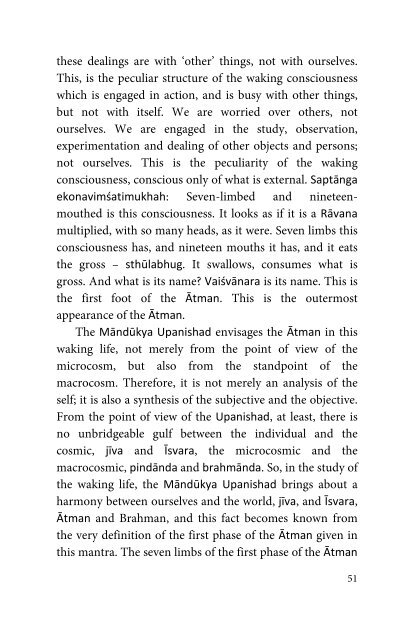Mandukya_Upanishad
Mandukya_Upanishad
Mandukya_Upanishad
You also want an ePaper? Increase the reach of your titles
YUMPU automatically turns print PDFs into web optimized ePapers that Google loves.
these dealings are with ‘other’ things, not with ourselves.This, is the peculiar structure of the waking consciousnesswhich is engaged in action, and is busy with other things,but not with itself. We are worried over others, notourselves. We are engaged in the study, observation,experimentation and dealing of other objects and persons;not ourselves. This is the peculiarity of the wakingconsciousness, conscious only of what is external. Saptāngaekonavimśatimukhah: Seven-limbed and nineteenmouthedis this consciousness. It looks as if it is a Rāvanamultiplied, with so many heads, as it were. Seven limbs thisconsciousness has, and nineteen mouths it has, and it eatsthe gross – sthūlabhug. It swallows, consumes what isgross. And what is its name? Vaiśvānara is its name. This isthe first foot of the Ātman. This is the outermostappearance of the Ātman.The Māndūkya <strong>Upanishad</strong> envisages the Ātman in thiswaking life, not merely from the point of view of themicrocosm, but also from the standpoint of themacrocosm. Therefore, it is not merely an analysis of theself; it is also a synthesis of the subjective and the objective.From the point of view of the <strong>Upanishad</strong>, at least, there isno unbridgeable gulf between the individual and thecosmic, jīva and Īsvara, the microcosmic and themacrocosmic, pindānda and brahmānda. So, in the study ofthe waking life, the Māndūkya <strong>Upanishad</strong> brings about aharmony between ourselves and the world, jīva, and Īsvara,Ātman and Brahman, and this fact becomes known fromthe very definition of the first phase of the Ātman given inthis mantra. The seven limbs of the first phase of the Ātman51



